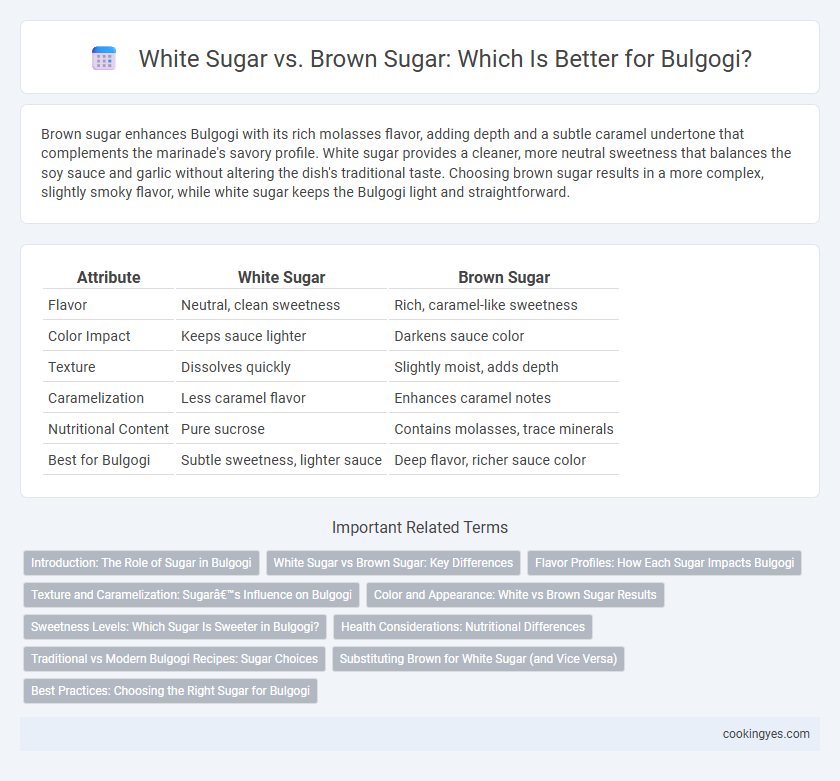Brown sugar enhances Bulgogi with its rich molasses flavor, adding depth and a subtle caramel undertone that complements the marinade's savory profile. White sugar provides a cleaner, more neutral sweetness that balances the soy sauce and garlic without altering the dish's traditional taste. Choosing brown sugar results in a more complex, slightly smoky flavor, while white sugar keeps the Bulgogi light and straightforward.
Table of Comparison
| Attribute | White Sugar | Brown Sugar |
|---|---|---|
| Flavor | Neutral, clean sweetness | Rich, caramel-like sweetness |
| Color Impact | Keeps sauce lighter | Darkens sauce color |
| Texture | Dissolves quickly | Slightly moist, adds depth |
| Caramelization | Less caramel flavor | Enhances caramel notes |
| Nutritional Content | Pure sucrose | Contains molasses, trace minerals |
| Best for Bulgogi | Subtle sweetness, lighter sauce | Deep flavor, richer sauce color |
Introduction: The Role of Sugar in Bulgogi
White sugar and brown sugar both play crucial roles in Bulgogi, enhancing its characteristic sweet and savory flavor profile. White sugar provides a clean, straightforward sweetness that balances the salty soy sauce, while brown sugar adds depth with its molasses content, contributing a richer, caramel-like taste. The choice between white and brown sugar affects the marinade's color, texture, and complexity, influencing the overall sensory experience of Bulgogi.
White Sugar vs Brown Sugar: Key Differences
White sugar and brown sugar differ primarily in their molasses content, which significantly impacts the flavor and texture of Bulgogi marinades. White sugar offers a cleaner sweetness and lighter color, enhancing the meat's caramelization without altering its color, while brown sugar adds a deeper, more complex molasses-rich flavor that contributes to a slightly darker, richer marinade. Choosing between white sugar and brown sugar for Bulgogi depends on whether a subtler sweetness or a robust, molasses-enhanced taste is desired, affecting both the dish's taste profile and appearance.
Flavor Profiles: How Each Sugar Impacts Bulgogi
White sugar imparts a clean, straightforward sweetness that enhances Bulgogi's savory and umami flavors without overpowering the dish. Brown sugar adds a richer, deeper molasses undertone, creating a caramelized complexity that intensifies the marinade's depth. The choice between white and brown sugar significantly influences the balance of sweetness and complexity in Bulgogi's flavor profile.
Texture and Caramelization: Sugar’s Influence on Bulgogi
Brown sugar enhances Bulgogi's texture by adding moisture and a subtle molasses note, resulting in a tender and juicy bite. White sugar promotes sharper caramelization due to its pure sucrose content, creating a crispier surface with a balanced sweetness. Choosing between brown and white sugar significantly affects the caramelization depth and texture consistency in Bulgogi dishes.
Color and Appearance: White vs Brown Sugar Results
Using white sugar in Bulgogi results in a lighter, more translucent glaze that enhances the natural color of the marinated beef, creating a bright and visually appealing dish. Brown sugar imparts a richer, deeper caramel hue with a slightly glossy finish, contributing to a darker and more rustic appearance. The molasses content in brown sugar intensifies the color contrast, making the meat look more robust and flavorful compared to the subtler sheen produced by white sugar.
Sweetness Levels: Which Sugar Is Sweeter in Bulgogi?
Brown sugar has a richer, more complex sweetness due to its molasses content, enhancing Bulgogi's flavor with subtle caramel and toffee notes. White sugar offers a cleaner, sharper sweetness that highlights the savory marinade without altering the dish's color. In terms of sweetness intensity, white sugar is slightly sweeter by volume, but brown sugar adds depth, making it a preferred choice for traditional Bulgogi recipes.
Health Considerations: Nutritional Differences
White sugar and brown sugar both provide calories primarily from sucrose, but brown sugar contains small amounts of minerals like calcium, potassium, iron, and magnesium due to its molasses content. The glycemic index of white sugar and brown sugar is similar, causing comparable impacts on blood sugar levels when used in Bulgogi marinade. Choosing brown sugar may offer slight nutritional advantages, but both sugars should be used in moderation to maintain health, especially for individuals managing blood glucose or caloric intake.
Traditional vs Modern Bulgogi Recipes: Sugar Choices
Traditional Bulgogi recipes often use white sugar for its clean, sweet flavor that enhances the marinated beef without overpowering the other ingredients. Modern Bulgogi recipes increasingly incorporate brown sugar, which adds a deeper caramel note and slight molasses richness, creating a more complex taste profile. The choice between white and brown sugar influences the final dish's color, texture, and flavor intensity, reflecting evolving culinary preferences and ingredient availability.
Substituting Brown for White Sugar (and Vice Versa)
Substituting brown sugar for white sugar in Bulgogi enhances the dish with a deeper caramel flavor and slight molasses richness, elevating the marinade's complexity. Brown sugar's moisture content can also contribute to a more tender texture in the marinated beef compared to the crisper results from white sugar. When replacing brown sugar with white sugar, consider adding a small amount of molasses or honey to mimic the richer taste and maintain the signature sweet-savory balance of traditional Bulgogi.
Best Practices: Choosing the Right Sugar for Bulgogi
Brown sugar is often preferred for bulgogi due to its richer molasses content, which enhances the marinade's depth and caramelization during cooking. White sugar provides a cleaner, sweeter flavor but lacks the complex notes that brown sugar contributes, potentially resulting in a less savory profile. For authentic bulgogi, selecting brown sugar ensures a balanced sweetness and a more traditional, robust taste.
White sugar vs brown sugar for Bulgogi Infographic

 cookingyes.com
cookingyes.com